Let’s take it: the majority of posts you’ve ever read about email marketing were about HTML-based emails in the best traditions ― well-designed and full of images, catchy fonts, and buttons. Meanwhile, little is usually said about their black-and-white fellow, a plain-text email.
This is why, in this post, we will unveil the real story behind this forgotten-by-many type of email and tell you why you should include it in your marketing campaigns.
Outline:
What is a plain-text email?
A plain-text email is a simple email message that includes only text. It contains basic fonts, URLs that are typed out, and neither special style nor images. This email resembles the one you have recently sent to one of your colleagues or friends, just like the one I got not long ago:

Let’s discuss the benefits of plain-text emails for your marketing campaigns, as well as some points that may be considered their cons.
Pros of plain-text emails
A plain-text email can’t boast of fancy visual elements and is used by 16% of marketers so far. Still, this type of email may become your best friend when you need to reach out to people to say the first word about your company, i.e., for your outbound marketing campaigns.
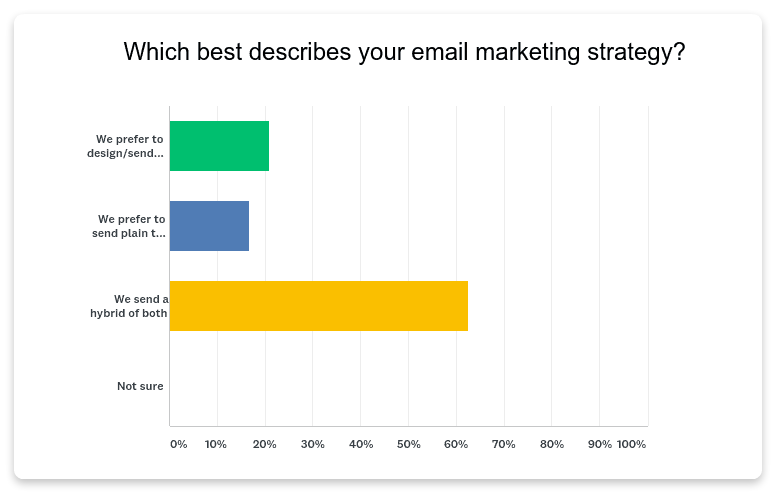
So, what are its main benefits?
Plain-text emails have higher deliverability
Unlike HTML emails, plain-text messages don’t usually trigger any spam filters and don’t signal any suspicion with blocked images. Thus, email providers let them fly confidently to the user’s inbox.
Besides, with plain-text emails, you may be sure to avoid the Promotions tab. The absence of images and lack of formatting help them keep a personal tone of voice, so they are not perceived as salesy. On the contrary, HTML-based campaigns can hardly hide their promotional nature from email providers.
As a result, with plain-text emails, you have more chances of reaching your subscribers — your first point of success on the way to email conversion.
Plain-text emails have fewer technical issues
Plain-text emails load fast since there is not much to load, except the text. What is more, with this type of messages, you shouldn’t worry about images to be blocked or other features to be broken. You may be sure they will look the same on different devices, whether laptops, mobile phones, or tablets.
Finally, the absence of technical problems makes this email type friendly to people with disabilities.
Plain-text emails have higher opens and clicks
Considering plain-text emails are more deliverable, they are bound to get 42% more clicks. By contrast, adding even one image to your email reduces click rates. Not the best outcome, yeah?

Plain-text emails are more personal
Receiving 121 emails a day, the average user is more inclined to disregard messages that seem commercial. Instead, they welcome the content that creates a more intimate vibe, the one that would make them feel they are chatting with their friend.
And even though plain-text emails are devoid of incredible design and can’t be customized, remember there are many ways to personalize them. You may find handy personalization options in one of our posts.
Plain-text emails have a promising future
You may think that plain-text emails look like a quaint anachronism from the previous century, but they are quite ahead of time. Modern devices such as smartwatches are becoming popular with each day. They allow us to check emails on the go and can depict only text-messages on their screen. That’s why plain-text emails seem to be a perfect solution for the tech of the future.
Now let’s define what may not make plain-text emails so attractive, apart from such evident factors as the absence of good formatting and design, already highlighted above.
Cons of plain-text emails
Plain-text emails don’t favor brand promotion
Email is a wonderful opportunity for businesses to cultivate their brand recognition among subscribers. Companies insert their remarkable logos or images in their corporate color scheme with the only reason — to arouse brand awareness in their audience. With plain-text emails, however, emphasizing your company’s identity becomes more difficult.
Plain-text emails don’t have a prominent CTA
Since you can’t create stylish visual elements, you also can’t highlight your call-to-action (CTA). Neither can you place a CTA button several times throughout your email to catch your reader’s eye. Thus, take your effort and time to make your CTA visible.
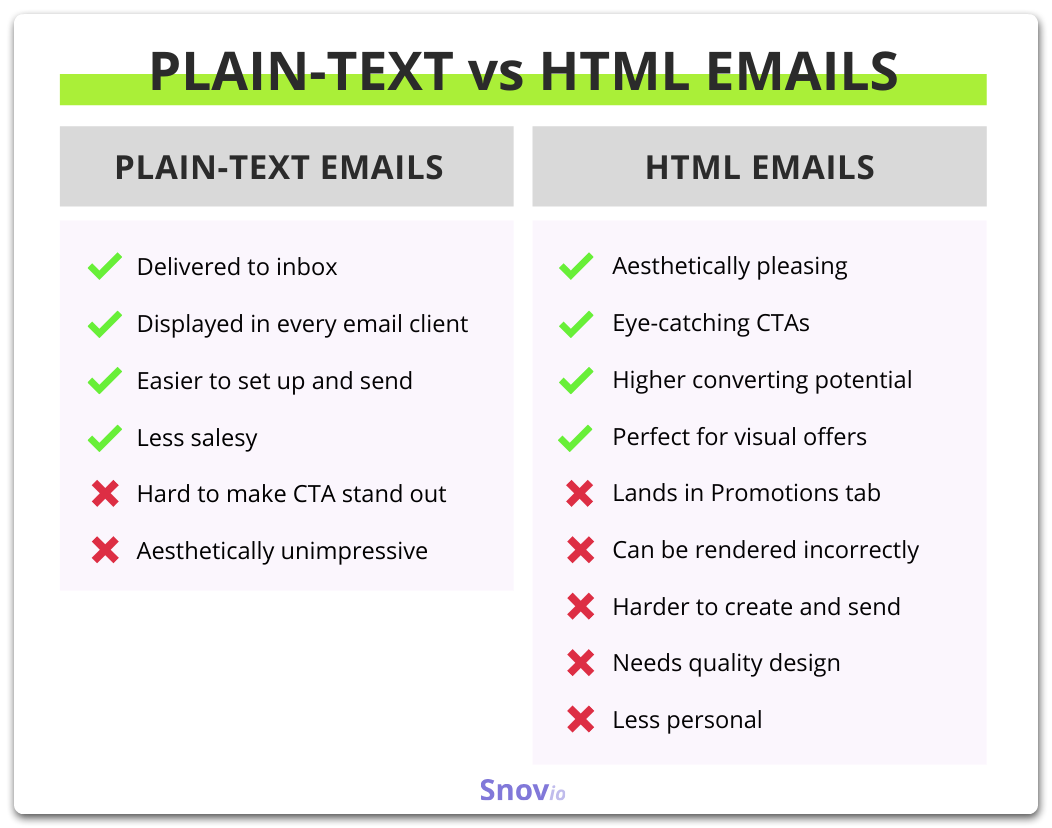
How to optimize your plain-text email copy
Even if your choice is a plain-text email, you should still think about how to make its copy attractive. Reading plain-text messages may not be an easy activity for your users. So, make sure they are scannable.
There are several ways to do it:
Avoid long reads
This is the first rule you should comply with if you want your subscribers to read your plain-text email till the end. The absence of images is already a strong punch for your email readability. Don’t aggravate it with a lengthy message, which will look like a legal document.
Highlight headlines
While you can’t use colors and special fonts to make headlines stand out from other content, you can use textual tools, such as CAPS or symbols. For instance:
- MARKETING AUTOMATION PLATFORMS
- ** Marketing Automation Platforms
Include enough white space
To make your plain-text email easy to follow, make sure you leave enough space between different content sections, headlines, or CTAs by breaking the lines. Besides, you may add border lines to make the paragraph division even more noticeable.
Make your CTA stand out
As mentioned, with plain-text emails, you can’t rely on prominent CTA buttons. Yet, you should put effort into making your CTA stand out. For instance, if it involves a link, use a kind of a lead-in phrase before. Besides, some marketers recommend using two angle brackets (>>) to draw attention to the CTA. Consider how it may be used in your email:
- Study more information about the online course: [link]
- >> Study more information about the online course: [link]
Don’t overuse links
Readers are often bothered by too many CTA buttons beaming out throughout the HTML email. It’s even worse when it comes to plain-text messages where endless links may become a real disaster. Be merciful to your subscribers and try a minimalistic approach. Structure your email so that you’ll embed links only to the most important information.
Now let’s see how these optimization recommendations work in practice. Here is an excerpt from a plain-text email, which, I am sure, you would wish to optimize after reading our tips:
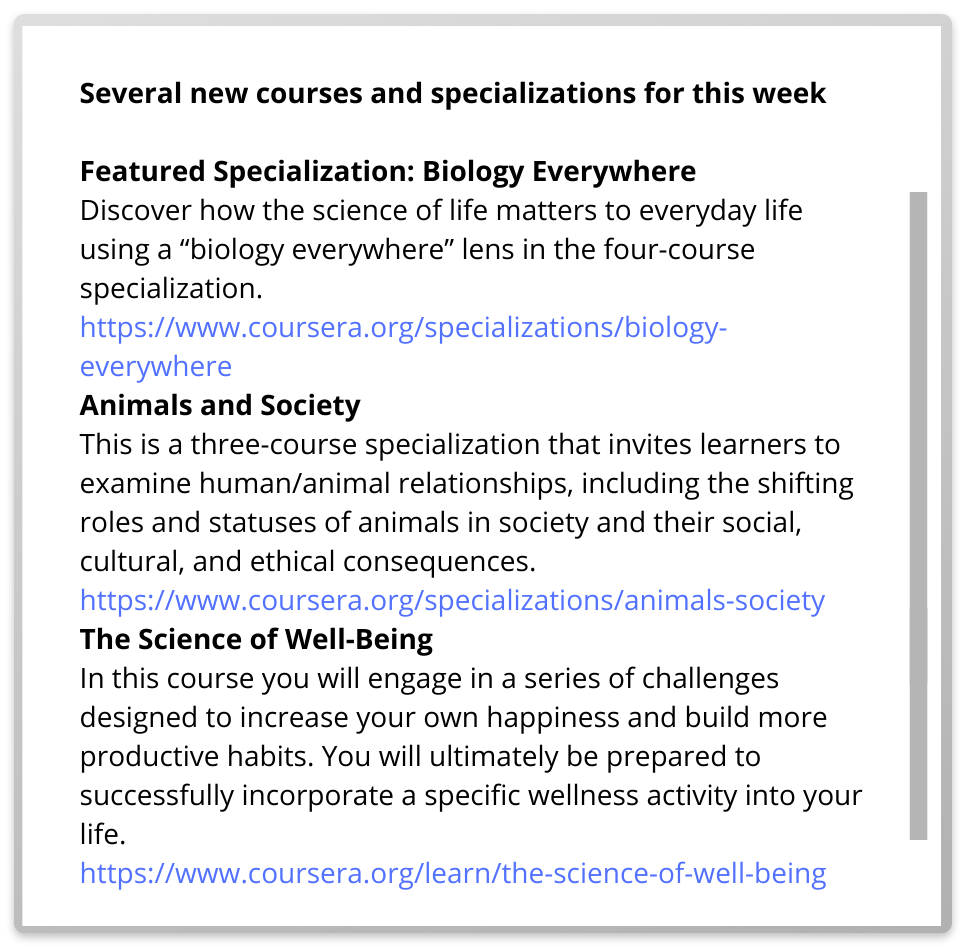
There are several issues that make this example not the best choice. First, headlines are not separated from the rest of the content due to the absence of white space. And then links seem to be added out of the blue as there are no lead-in phrases to define the clear CTA.
And here is the improved version of this email:
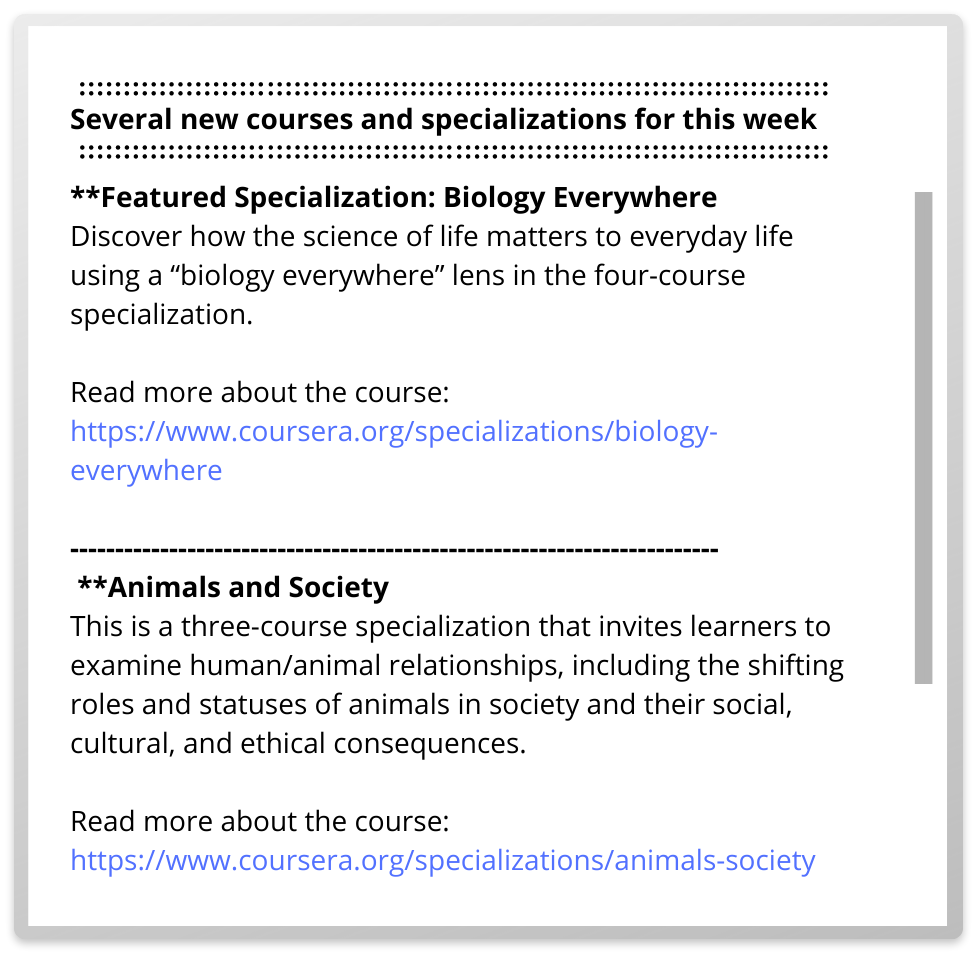
As you can see, the message’s main topic is clearly defined, headlines are marked with asterisks (**), there is enough space between sections, and the CTA is distinct due to the clear lead-in phrase “Read more about the course.”
Test your emails
Do you know that 39% of brands don’t test their segmented emails? You shouldn’t miss out on that. Even if you deal with plain-text messages, A/B testing will help you make sure your emails perform at their best. For example, you may compare headlines in CAPS against those in bold or check whether adding “>>” before the CTA brings more conversion.
So, are plain-text emails the right solution for your business?
Since the advantages of plain-text emails considerably surpass their cons, the reply is supposed to be ‘Yes.’ Besides, plain-text emails overrun their HTML neighbors when it comes to opens and clicks, which again proves that email marketing is where simplicity wins.
Yet, I wouldn’t say that the answer to this question is so apparent. Sometimes what suits one business can’t be the same good for another. Frankly, I doubt that sharks such as Nike or Apple use plain-text emails to showcase their best offers. So, what are alternative solutions?
Multipart MIME
Users of a single company also differ, and clever marketers know they should send emails based on the preferences of each person on their email list. But even if your subscribers prefer HTML format, which, as you remember, often faces some hurdles on the way to their inbox, you should ensure they will get your message anyway.
Therefore, a wise decision is using Multipart MIME (Multipurpose Internet Mail Extensions). This process boils down to sending out your emails and including both HTML and plain-text formats. It lets you send:
- HTML emails to users who can view that content
- Plain-text emails to subscribers who can’t view HTML formatting
- Plain-text emails to users who unsubscribed from HTML emails
- Messages based on what your user’s email server allows
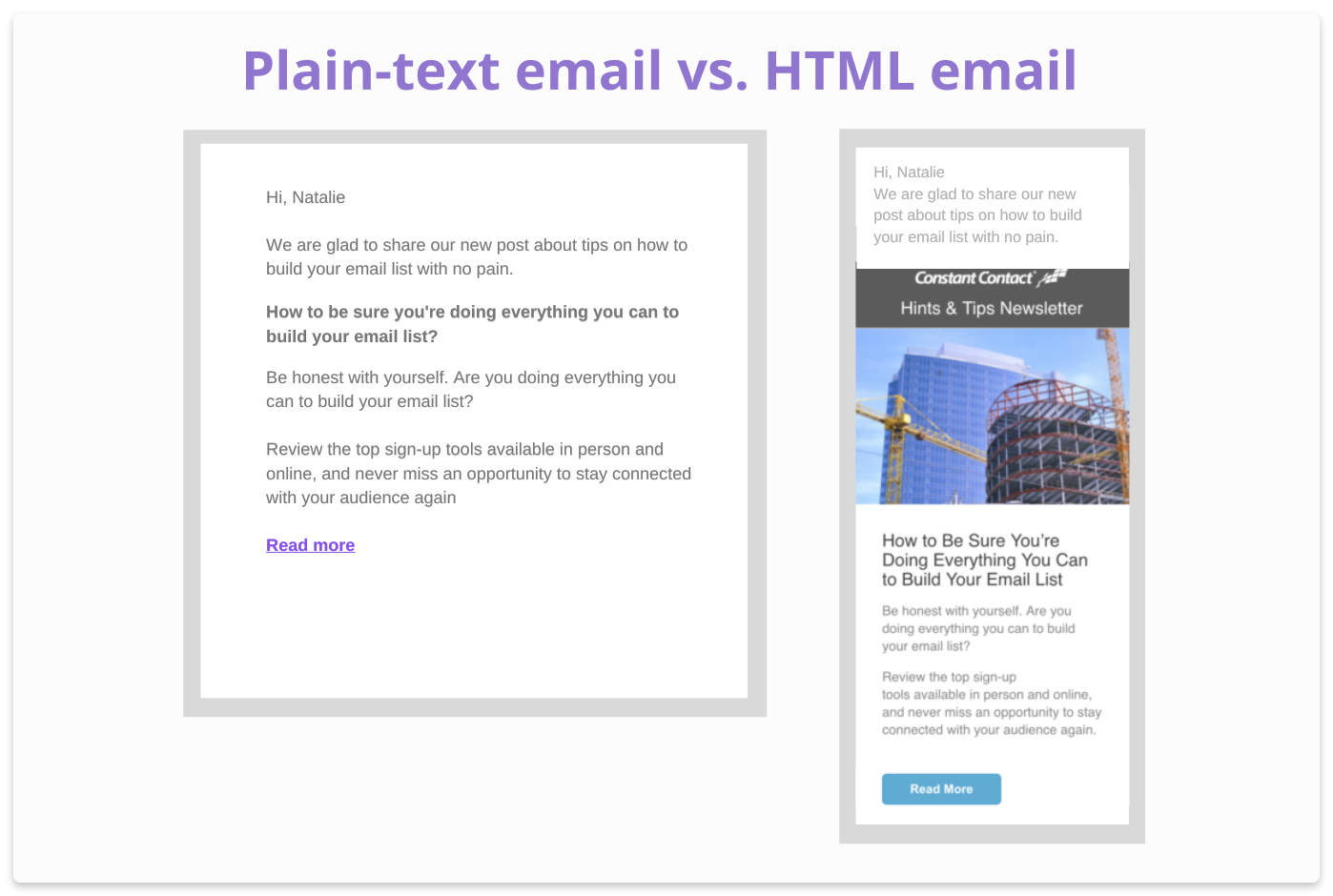
Hybrid emails
Many companies incorporate so-called hybrid emails into their marketing campaigns, which are HTML messages with minimum formatting that are imitating plain-text emails. They appear personal and handwritten, yet retain HTML’s tracking ability. Snov.io cold email software allows you to build triggered hybrid emails, automating their flow based on your reader’s behavior.
By sending such messages, you’ll be able to kill two birds with one shot: to create brand awareness among your readers and not to annoy them with too promotional content.
For example, let’s look at the email I’ve recently got from Neil Patel:

Yes, it looks like a regular plain-text email, but in fact, this is an HTML message. Nothing difficult, just email marketing tricks.
Wrapping it up
If you caught yourself thinking that plain-text email is an age-old story, we hope our article has dispelled all your doubts. On the one hand, this type of email can’t boast of perfect fashion and formatting. On the other hand, it has more chances of being delivered to your reader’s inbox, increasing your metrics, and winning the user’s hearts. Why then leave this too advantageous email type in the backyard of your marketing campaign?



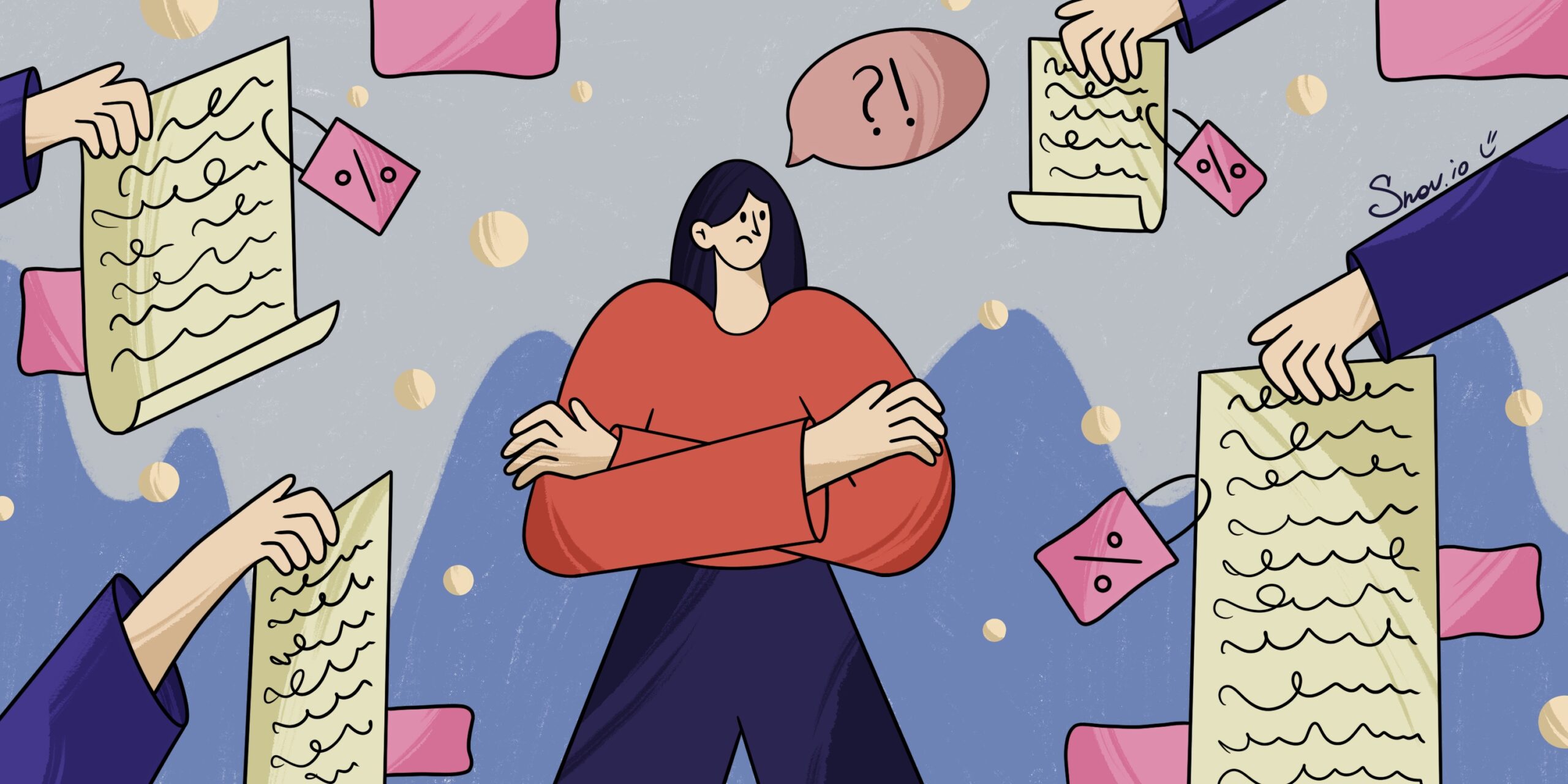


Prexifing headlines with double angle brackets is a bad advice. Most email clients (all but Outlook) will interpret that as a second-level quotation. It may be displayed with a full gray color or get completely hidden! Use anything but space, “>”, and “– “.
Here’s some good advice:
Put links on their own lines with a blank line above and below it. It makes it much easier to copy it out of the message and reduces the chance of accidentally breaking it by line-wrapping. The links should ideally be human-readable and self-describing.
Use short authentic links from your brand’s domain name. Ideally, 78 characters or less. At all cost avoid links with long scary looking random strings that redirect through an unfamiliar email marketing domain.